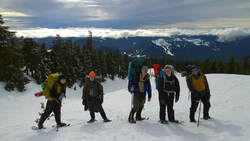Cascadia Wildlife Blog
News from the Wolverine Tracking Project and more
|
We had camera checks at Bear Springs Far, Clear Lake, and Government Camp West, plus our intrepid trackers went snow camping near Timberline. Check out what they found, plus hear about a couple upcoming events! The overnight tracking trip (as well as all the snow in the city!) has us thinking about what we need to do to stay warm - and gets us thinking of all the different ways the animals in our region are specialized to deal with this winter weather. Tracking Trip Updates The snow tracking survey trip this week did an overnight trip to the Timberline area. They followed a marten trail, then in the evening some of them were amibitious enough to build snow shelters to help stay warm. The shelter below looks quite cozy!  This marten was traveling with a very unusual gait, but if you look closely, you can see 5 toes on all four feet. Wildlife Camera Findings Coyotes' ability to capitalize on any available resources might be one of their greatest adaptations that serves them through winter. Rodents? Great! Deer? Sounds good! Nuts and berries? Love it! Bobcats (and lynx, too) are unusual in the feline family because of their short tails. Perhaps due to their preference to hunt in dense, woody areas, a long tail was no longer necessary in their quick-pivoting, brushy chases - similar to the Coopers Hawk, which has shorter, rounded wings for hunting among the tree branches. Round two of the weasel escapades! This camera station is undoubtedly this weasel's favorite place to pass the time. The last camera set was a tale of weasel-vs-woodrat, while this set found a competitor-less weasel luxuriously enjoying its surroundings. (Check out the full sets for weeks of this weasel bounding and jumping through the days) Weasels are extremely inefficient at conserving heat due to their high-surface-area body shape. To counteract this, they have an extremely high metabolism that keeps them on the move and searching for food. When they're lucky, the catch prey that had a nice, warm den for them to commandeer! Snowshoe hares have adapted in many ways we are all familiar with, like their extremely large, furry hind feet that keep them up on top of the snow. Additionally, snowshoe hares typically turn white at the beginning of winter. In some areas, however, this change does not occur due to the lack of reliable and consistent snowfall. This is a good thing for these creatures, as their bright white fur would be a dead give-away on a brown, snowless day.
0 Comments
|
Categories
All
Past Posts
May 2024
|
|
|
Copyright © 2021
|